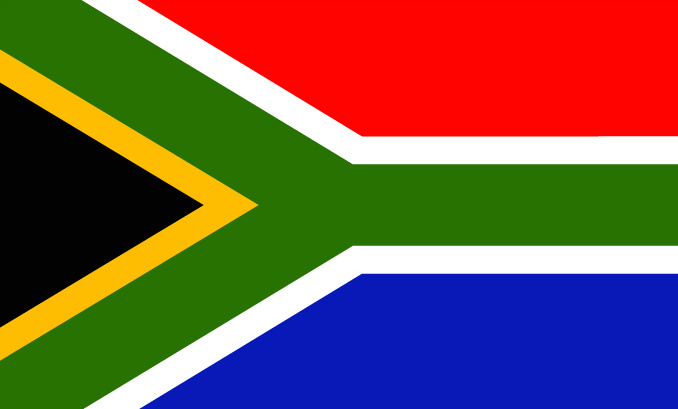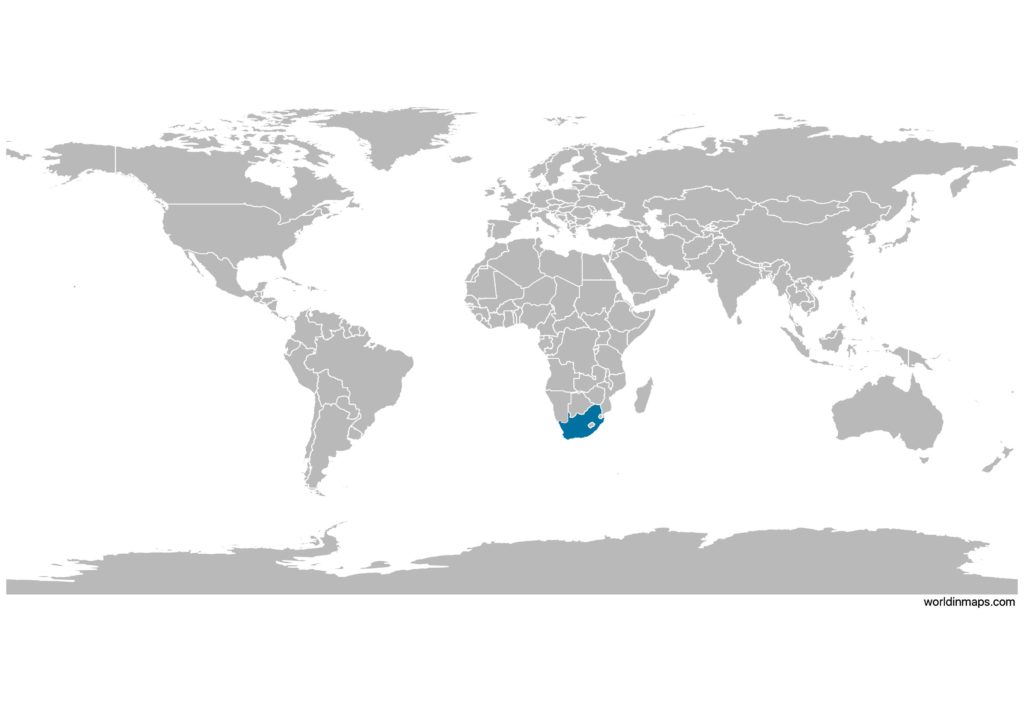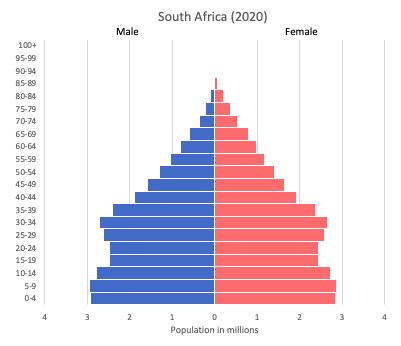South Africa

| Government | |
| Name | Republic of South Africa |
| Government type | parliamentary republic |
| Executive capital | Pretoria (2,437,000 (2018)) |
| Legislative capital | Cape Town (4,004,793 (2018)) |
| Judicial capital | Bloemfontein (759,693 (2018)) |
| Currency | South African rand (ZAR) |
| Organization | |
| Member State | Commonwealth of Nations |
| People | |
| Population (2020) | 59,308,690 (24th) |
| Density of population | 42.4 P/km2 (169th) |
| Nationality | South African |
| Official languages | |
| isiZulu | |
| isiXhosa | |
| Afrikaans | |
| Sepedi | |
| Setswana | |
| English | |
| Sesotho | |
| Xitsonga | |
| siSwati | |
| Tshivenda | |
| isiNdebele | |
| Ethnic groups (2018) | |
| black African | 80.9% |
| colored (mixed) | 8.8% |
| white | 7.8% |
| Indian / Asian | 2.5% |
| Religions (2015) | |
| Christian | 86% |
| ancestral, tribal, animist, or other traditional African religions | 5.4% |
| Muslim | 1.9% |
| other | 1.5% |
| nothing in particular | 5.2% |
| Life expectancy (2020) | |
| Male | 63.4 years |
| Female | 66.2 years |
| Total population | 64.8 years (198th) |
| Homicides | |
| Total (2017) | 35.9 per 100,000 people (9th) |
| Geography | |
| Land area | 1,214,470 km2 |
| water area | 4,620 km2 |
| total area | 1,219,090 km2 (26th) |
| Mean elevation | 1,034 m |
| Lowest point | |
| Atlantic Ocean | 0 m |
| Highest point | |
| Njesuthi | 3,408 m |
| Land use (2011) | |
| Agricultural land | 79.4% |
| Arable land | 9.9% |
| Permanent crops | 0.3% |
| Permanent pasture | 69.2% |
| Forest | 7.6% |
| Other | 13% |
| Urbanization | |
| Urban population (2020) | 67.4% |
| Rate of urbanization | 1.97% annual rate of change (2015 – 2020) |
| Economy | |
| Labor force (2017) | 22.19 million (29th) |
| Labor force by occupation (2014) | |
| Agriculture | 4.6% |
| Industry | 23.5% |
| Services | 71.9% |
| Unemployment rate (2017) | 27.5% (200th) |
| GDP (PPP) (estimate 2019) | |
| Total | $813.100 billion (30th) |
| Per capita | $13,865 (89th) |
| GDP (nominal) (estimate 2019) | |
| Total | $371.298 billion (33rd) |
| Per capita | $6,331 (86th) |
| GDP by sector (estimate 2017) | |
| Agriculture | 2.8% |
| Industry | 29.7% |
| Services | 67.5% |
| Exports (2017) | $94.93 billion (39th) |
| Exports partners (2017) | |
| China | 9.5% |
| US | 7.7% |
| Germany | 7.1% |
| Japan | 4.7% |
| India | 4.6% |
| Botswana | 4.3% |
| Namibia | 4.1% |
| Imports (2017) | $89.36 billion (40th) |
| Imports partners (2017) | |
| China | 18.3% |
| Germany | 11.9% |
| US | 6.6% |
| Saudi Arabia | 4.7% |
| India | 4.7% |
South Africa on the world map

South Africa top 10 largest cities (2018)
- Johannesburg (9,167,045)
- Cape Town (4,004,793)
- Durban (3,661,911)
- Pretoria (2,437,000)
- Port Elizabeth (1,263,051)
- Vereeniging (957,528)
- Soshanguve (841,000)
- East London (810,528)
- Bloemfontein (759,693)
- Pietermaritzburg (679,766)
Demography
Population pyramid

Age structure data
Estimate for 2020:
- 0-14 years: 27.94% (male 7,894,742/female 7,883,266)
- 15-24 years: 16.8% (male 4,680,587/female 4,804,337)
- 25-54 years: 42.37% (male 12,099,441/female 11,825,193)
- 55-64 years: 6.8% (male 1,782,902/female 2,056,988)
- 65 years and over: 6.09% (male 1,443,956/female 1,992,205)
Remark: the age structure of a population affects a nation’s key socioeconomic issues. Countries with young populations (high percentage under age 15) need to invest more in schools, while countries with older populations (high percentage ages 65 and over) need to invest more in the health sector. The age structure can also be used to help predict potential political issues. For example, the rapid growth of a young adult population unable to find employment can lead to unrest.
Population from 1950 to 2020
Source: United Nations, Department of Economic and Social Affairs, Population Division (2019). World Population Prospects 2019, Online Edition. Rev. 1.
Evolution of the life expectancy from 1960 to 2018
Source: World Development Indicators, The World Bank
Major rivers
Economy
Agriculture:
corn, wheat, sugarcane, fruits, vegetables, beef, poultry, mutton, wool, dairy products
Industries:
mining (world’s largest producer of platinum, gold, chromium), automobile assembly, metalworking, machinery, textiles, iron and steel, chemicals, fertilizer, foodstuffs, commercial ship repair
Exports – commodities:
gold, diamonds, platinum, other metals and minerals, machinery and equipment
Imports – commodities:
machinery and equipment, chemicals, petroleum products, scientific instruments, foodstuffs
Time zone and current time in South Africa
Go to our interactive map to get the current time in South Africa